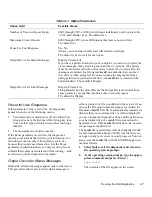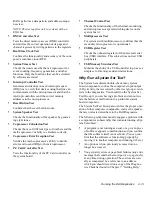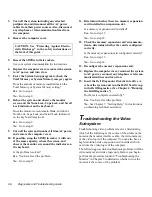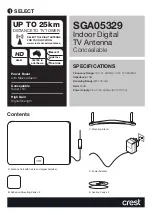
4-18
Diagnostics and Troubleshooting Guide
•
Audio Output Test
Causes the drive to begin playing the first audio
track on an audio CD. To determine whether the test
passed, listen to the audio output of the drive.
NOTE: To conduct the Audio Output Test, you must
select it individually. It will not run as part of the test
group.
•
Eject Removable Media
Checks the drive’s ability to eject its CD.
Why Run an IDE CD ROM Drives Test?
If you encounter a problem while using an application
program on a CD, the problem could result from the disc
or from the drive. When you encounter problems, first try
using a different CD. If the problem recurs, run the IDE
CD ROM Drives Test Group.
These are the most common symptoms that might prompt
you to test an IDE CD-ROM drive:
•
Seek errors are reported by the operating system or
application programs.
•
An error message appears on the screen stating that
the computer cannot read from an IDE CD-ROM
drive (typically, drive D or drive E).
S
erial/Infrared Ports Test Group
The subtests in the Serial/Infrared Ports Test Group
check the computer’s interface with external devices,
such as a printer and a mouse, that are connected to the
computer through a serial or infrared port. The subtests in
this test group are not intended as a diagnostic test for the
actual peripheral attached to each port.
NOTES: With certain modems installed, the Serial/
Infrared Ports Test Group subtests may fail because the
modem appears to the Dell Diagnostics as a serial or
infrared port, but it cannot be tested as a serial or infra-
red port. If a modem is installed and one of the serial/
infrared ports subtests fails, remove the modem and run the
diagnostic tests again.
If an external loopback connector is not attached to a
serial or infrared port, the Serial External Transmission
Test will fail for that port and the results of this test
should therefore be ignored. An external modem con-
nected to the port does not substitute for an external
loopback connector.
Subtests
The four subtests in the Serial/Infrared Ports Test Group
confirm the following port functions:
•
Serial/Infrared Baud Rate Test
Checks the baud rate generator in each serial com-
munications chip against the computer’s clock
•
Serial/Infrared Interrupt Test
Checks the serial port’s ability to send IRQs to the
microprocessor
•
Serial/Infrared Internal Transmission Test
Checks several internal functions of the serial port
using the internal loopback mode of the serial com-
munications chip
•
Serial External Transmission Test
If a loopback device is attached, checks the line con-
trol bits of the serial port and sends a test pattern at
several baud rates, checking the returned values
Why Run a Serial/Infrared Ports Test?
If the Dell Diagnostics does not recognize your com-
puter’s serial or infrared ports, enter the System Setup
program and check the Serial/infrared Port category to
see whether the port has been disabled. The subtests in
the Serial/Infrared Ports Test Group cannot test a port
unless it is enabled.
When a port is faulty, it may not be immediately evident
that the port, and not the device connected to the port, is
faulty. Instead, the peripheral (such as a printer or mouse)
might behave erratically or not operate at all. If the
external device is not properly installed through your
software, it also may not function properly. Try operating
the peripheral from different programs or through the
operating system. If it still does not work, you can
eliminate the software configuration as the cause of the
problem.
Summary of Contents for OptiPlex HUB
Page 1: ... 1267 6 1 7528 6 227 1 8 ...
Page 2: ......
Page 3: ... 1267 6 1 7528 6 227 1 8 ...
Page 10: ...x ...
Page 18: ...xx DELL CONFIDENTIAL Preliminary 2 10 98 ...
Page 20: ...xxii DELL CONFIDENTIAL Preliminary 2 10 98 ...
Page 38: ...2 14 Diagnostics and Troubleshooting Guide ...
Page 42: ...3 4 Diagnostics and Troubleshooting Guide ...
















































